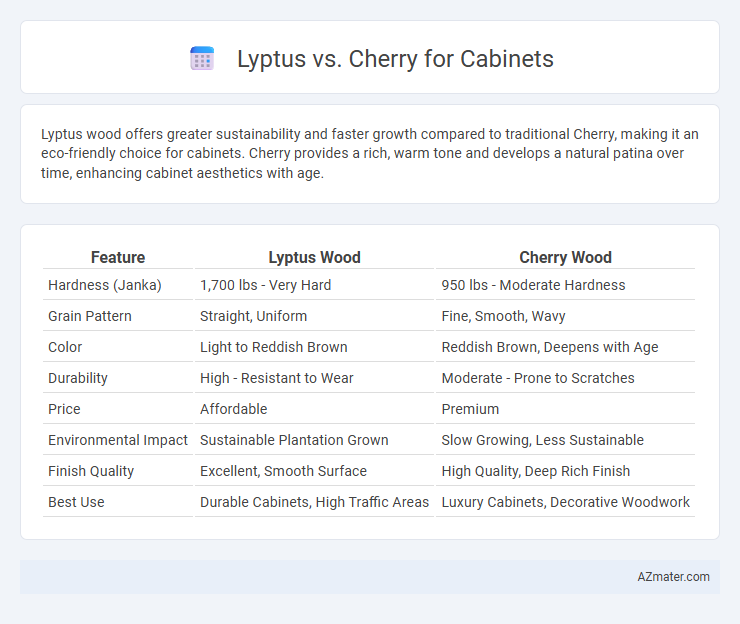Lyptus wood offers greater sustainability and faster growth compared to traditional Cherry, making it an eco-friendly choice for cabinets. Cherry provides a rich, warm tone and develops a natural patina over time, enhancing cabinet aesthetics with age.
Table of Comparison
| Feature | Lyptus Wood | Cherry Wood |
|---|---|---|
| Hardness (Janka) | 1,700 lbs - Very Hard | 950 lbs - Moderate Hardness |
| Grain Pattern | Straight, Uniform | Fine, Smooth, Wavy |
| Color | Light to Reddish Brown | Reddish Brown, Deepens with Age |
| Durability | High - Resistant to Wear | Moderate - Prone to Scratches |
| Price | Affordable | Premium |
| Environmental Impact | Sustainable Plantation Grown | Slow Growing, Less Sustainable |
| Finish Quality | Excellent, Smooth Surface | High Quality, Deep Rich Finish |
| Best Use | Durable Cabinets, High Traffic Areas | Luxury Cabinets, Decorative Woodwork |
Introduction to Lyptus and Cherry Wood
Lyptus wood, a hybrid eucalyptus species, is known for its sustainability, fast growth, and dense, uniform grain, making it an eco-friendly alternative for cabinetry. Cherry wood, prized for its rich reddish-brown hue and smooth texture, offers classic beauty and excellent workability, favored in high-end furniture and cabinets. Both woods provide durability and aesthetic appeal, but Lyptus appeals to environmentally conscious buyers while Cherry carries a traditional, timeless character.
Botanical Origins and Growth Patterns
Lyptus, derived from Eucalyptus grandis and Eucalyptus urophylla hybrids, is a fast-growing hardwood native to Brazil, cultivated in managed plantations for sustainable timber production. Cherry, primarily Prunus serotina, is a slower-growing hardwood native to eastern North America, valued for its fine grain and rich reddish tones that develop over centuries. These different botanical origins and distinct growth rates influence their availability, environmental impact, and suitability for high-quality cabinetry.
Appearance and Grain Comparison
Lyptus wood offers a consistent, light reddish-brown color with a fine, uniform grain pattern that provides a clean and modern look for cabinetry. Cherry wood features a richer, warm reddish hue that deepens over time, showcasing a more varied and pronounced grain with natural swirls and waves. The smooth texture and subtle grain of Lyptus make it ideal for sleek contemporary designs, whereas Cherry's dynamic grain and color evolution suit traditional or rustic cabinetry styles.
Durability and Hardness Analysis
Lyptus wood, derived from fast-growing eucalyptus trees, offers high durability with a Janka hardness rating around 1600, making it resistant to dents and wear for cabinetry. Cherry wood, a traditional choice, has a lower Janka hardness of approximately 950, providing moderate durability but superior workability and a rich, warm aesthetic. For cabinet applications demanding robust resistance and longevity, Lyptus is preferable, while Cherry excels in decorative appeal with sufficient durability for moderate use.
Workability for Cabinet Making
Lyptus offers excellent workability for cabinet making due to its consistent grain and hardness, allowing smooth cutting, sanding, and finishing without excessive wear on tools. Cherry wood, prized for its fine, straight grain and moderate hardness, provides seamless shaping and carving, which enhances detailed cabinet designs and achieves a polished, warm finish. Both woods perform well in cabinet making, but Lyptus may offer a more uniform machining experience while Cherry excels in aesthetic refinement and ease of hand-working.
Environmental Sustainability Factors
Lyptus, a hybrid eucalyptus species, offers superior environmental sustainability compared to cherry wood due to its rapid growth rate and certified renewable sourcing from managed plantations, which reduces deforestation pressures on natural hardwood forests. Cherry wood, while durable and aesthetically valued, is slower growing and often harvested from older, natural forests, leading to higher ecological footprints and potential habitat disruption. Choosing Lyptus supports responsible forestry practices and lowers carbon emissions, making it a more eco-friendly option for sustainable cabinetry projects.
Cost and Availability
Lyptus wood offers a cost-effective alternative to cherry, typically priced lower while maintaining comparable durability for cabinet construction. Cherry wood tends to be more expensive due to slower growth rates and higher demand, impacting its availability and market price. Lyptus is more readily available from sustainable plantations, ensuring consistent supply, whereas cherry availability depends on limited hardwood forests and seasonal harvesting.
Finishing and Maintenance Tips
Lyptus wood offers a smooth and consistent grain that accepts stains and finishes evenly, making it ideal for achieving a uniform cabinet appearance. Cherry wood develops a rich patina over time, requiring regular conditioning and gentle cleaning to maintain its natural luster and prevent surface damage. To prolong the finish on both Lyptus and Cherry cabinets, use a mild soap solution for cleaning and avoid harsh chemicals or abrasive materials that can degrade the protective coating.
Popular Uses in Cabinetry
Lyptus wood is popular in cabinetry for its durability, smooth grain, and resistance to scratches, making it ideal for modern and high-traffic kitchen cabinets. Cherry wood stands out for its rich, warm tones and ability to develop a deep patina over time, frequently used in traditional and luxury cabinetry projects. Both woods offer distinct aesthetic qualities and performance, with Lyptus favored for eco-friendly, sustainable cabinetry and Cherry prized for its classic elegance in fine furniture and custom cabinets.
Choosing the Right Wood for Your Cabinets
Lyptus offers a sustainable alternative to traditional hardwoods with its fast growth and resistance to warping, making it ideal for eco-conscious cabinet choices. Cherry wood provides a rich, deep color and smooth grain that deepens over time, delivering a classic and elegant look favored in high-end cabinetry. Selecting the right cabinet wood depends on balancing durability, appearance, and environmental impact to fit your design goals and maintenance preferences.

Infographic: Lyptus vs Cherry for Cabinet
 azmater.com
azmater.com